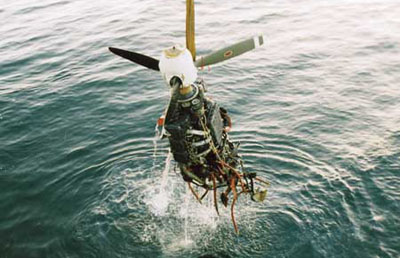The ATSB has issued three safety recommendations arising from
the ongoing investigation into the circumstances in which a Piper
PA31-350 Chieftain ditched in Spencer Gulf SA with the loss of
eight lives during a regular public transport (RPT) service from
Adelaide to Whyalla on 31 May 2000 (Occurrence 200002157). The
recommendations relate to mixture leaning procedures and the
carriage and use of life saving equipment.

Immediately prior to the accident the pilot gave a MAYDAY report
to Flight Service indicating that the aircraft had experienced two
engine failures. The investigation found mechanical damage to both
engines. The left engine had failed following a fatigue fracture of
the crankshaft at the No. 6 connecting rod journal. Cracks of this
type are created by the generation of thermal stresses in the
journal surface.
The No. 6 connecting rod "big end" bearing had failed and it was
evident that engine operation had continued after the bearing
shells had been broken down. The surface of the journal, and the
journal radii, had been damaged extensively by the rotation of the
journal against the connecting rod. Extensive thermal cracking was
evident over the entire journal surface.
In the right engine a hole had developed near the top of the No.
6 piston, allowing combustion gases to bypass the piston rings. The
hole had been created by an exposure to temperatures within the
melting range of the piston material. There were no failures of any
other structural components of the right engine.
The ATSB is examining a number of recent occurrences involving
Textron Lycoming TIO-540 series turbo-charged engines, similar to
those fitted to the PA31-350. Engineering analysis indicates that
the engines had typically been operated at or near peak exhaust gas
temperature (EGT).
The fuel mixture leaning practice adopted by the operators
during cruise flight was based on EGT settings ranging between 50
degrees (F) rich of peak and 50 degrees lean of peak EGT. While
this practice is in accordance with the PA31-350 pilot operating
handbook, early results suggest that operations in that EGT range,
in combination with other possible factors, may have contributed to
induced engine damage due to detonation.
This is in contrast to other operators who have not experienced
similar problems, and use a more conservative leaning procedure by
setting EGT at around 100 degrees rich of peak.
Induced damage may manifest itself through low compression, loss
of power, erratic operation, metal contamination in filters or even
complete engine stoppage. The underlying reasons for these symptoms
can include burnt pistons, stretched or 'tuliped' valves, cracked
spark plug ceramics or distressed bearings.
Operators can minimise the likelihood of such damage by
eliminating the possibility of detonation. It can be insidious, and
a pilot may not be aware that detonation is occurring.
Pending the outcome of its investigation of these issues, the
ATSB suggests that, in addition to following the guidance provided
in the pilot operating handbook, the operators of all turbo-charged
engines avoid high cylinder temperatures through the adoption of a
conservative approach to fuel mixture leaning practices.
Civil Aviation Orders 20.11 paragraph 5.1.2 details requirements
for the carriage of life jackets for over-water flight.
Multi-engine land aircraft authorised to carry nine passengers or
less on RPT or passenger charter operations are not required to be
equipped with life jackets or equivalent flotation devices unless
the aircraft is operated over water and at a distance from land of
greater than 50 NM. The Adelaide to Whyalla route was less than 50
NM from land.
Preliminary evidence indicates that the occupants of the
Chieftain would have had sufficient time to don life jackets had
they been provided. At least two of the occupants may have escaped
from the aircraft after it ditched, but subsequently drowned. Had
life jackets or equivalent flotation devices been available it is
possible that their chances of survival would have been greatly
increased.
The Australian Transport Safety Bureau has recommended
that:
-
the Civil Aviation Safety Authority alert operators of aircraft
equipped with turbo-charged engines to the potential risks of
engine damage associated with detonation, and encourage the
adoption of conservative fuel mixture leaning practices. [R20000250]. -
the Civil Aviation Safety Authority amend Civil Aviation Order
section 20.11 paragraph 5.1.2 to remove the restriction that it
only applies to aircraft authorised to carry more than nine
passengers. [R20000248]. -
the Civil Aviation Safety Authority ensures that Civil Aviation
Orders provide for adequate emergency and life saving equipment for
the protection of fare-paying passengers during over-water flights
where an aircraft is operating beyond the distance from which it
could reach the shore with all engines inoperative. [R20000249].


